Member Richard Bohner captured these superb detailed images of the crescent Moon on the 27th Dec 2022 from Arizona, USA. Amazing how much detail has been acquired using an iPhone camera held up to an eyepiece :-)
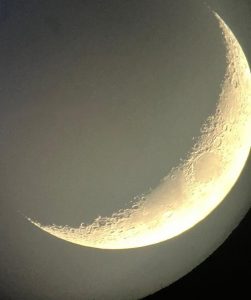
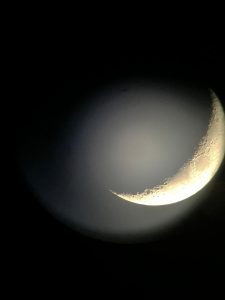
Astronomy every Thursday
Member Richard Bohner captured these superb detailed images of the crescent Moon on the 27th Dec 2022 from Arizona, USA. Amazing how much detail has been acquired using an iPhone camera held up to an eyepiece :-)


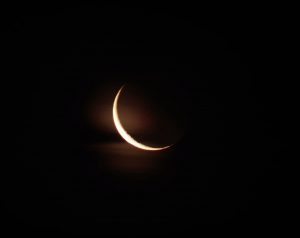
Member Jim Burchell's 'Winter Solstice crescent Moon' captured on the morning of the 21st Dec 2022 - The Winter Solstice. According to the astronomical definition, winter begins with the winter solstice in December in the Northern Hemisphere and in 2022 that was on the 21st Dec 2022.
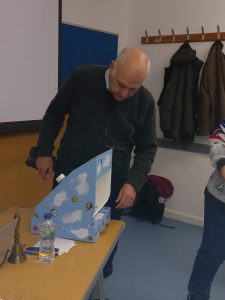
Member George Buckberry with his hand built Solar Projector
Last week following our Society meeting on the 26th January 2023, we learned about the design and construction of a table-top solar projector built by George Buckberry. After all of the effort involved in building the projector, George has very kindly donated it to the Society for use by members and also as a means of educating the public at one of our outreach events. Thank you George for your very kind donation.
Below is a link to George's PowerPoint presentation of how George built the Solar Projector in the form of a PDF file which you can download.
SolarScope Design & Build by George Buckberry of CMHASD

On the 17th Dec 2022 member George Buckberry captured this super image of Sirius, Orion, Hyades in Taurus with Mars above and the Pleiades. The photo was taken on a mobile Samsung SE20 in night mode and tweaked in Snapseed by George.

We will be hosting an observing evening at Hall Place & Gardens on Wednesday 1st March 2023. We hope to offer the chance to see some planets, deep sky objects and close up views of the Moon through a variety of telescopes weather permitting. There will also be a comet making demonstration and some indoor presentations too.
This is a ticket event. Tickets are available to purchase from the Hall Place & Gardens website. Click on the link below.
https://www.hallplace.org.uk/event/stargazing-2023/
It was a very busy night for CMHASD meteor camera on the 14th/15th Dec 2022. The Meteor camera captured 141 'sightings' of which 126 were meteors including 4 sightings of 2 meteors in the same shot by the camera. Out of the 126 meteors 98 were Geminids; the rest were other classes of meteors including some sporadics.
Meteors, also known as shooting stars, are pieces of dust and debris from space that burn up in Earth's atmosphere, where they can create streaks across the night sky. When Earth passes through the dusty trail of a comet or asteroid's orbit, the many streaks of light in the sky are known as a meteor shower. The 98 Geminid meteors detected by the camera were part of the annual Geminid meteor shower.
For more information about the society meteor camera & project click here.
For more information about the Geminid Meteor Shower please visit the UKMON website at https://ukmeteornetwork.co.uk/showers/2022-geminids/
Below are two out of the 4 photos showing the double meteors captured by the camera.
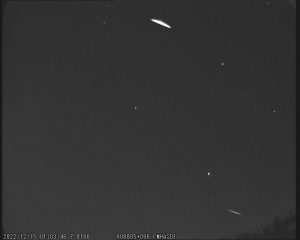
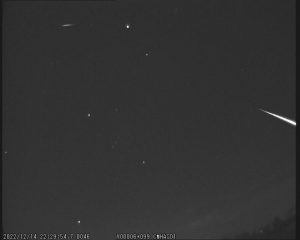
NEVER LOOK AT THE SUN DIRECTLY. Please see our Solar Observing safety page at crayfordmanorastro.com/solar-safety/
On the morning of Sunday 15th January 2023, CMHASD member Honor Wheeler captured this absolutely stunning image of the Sun. As you can see it was very active and still is! Details of how Honor acquired her brilliant image are on the photo.
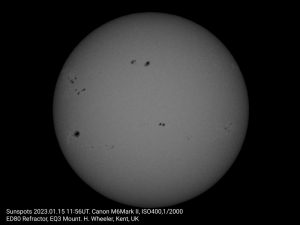
The information below is taken from the website Spaceweather.com
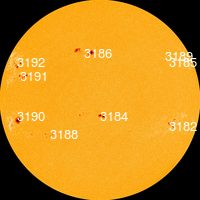
Picture above shows the Sun on 15th January 2023 - taken by the Solar Dynamics Observatory with the Sun spots labelled.
'''...I can't remember having seen so many sunspots together; indeed, the sunspot number is high. If solar activity continues at this pace for the rest of January, the monthly sunspot number will reach a 20-year high. And Solar Maximum is still ~2 years away. Contrary to predictions, Cycle 25 is shaping up to be a good one, after all.''
17th Jan 2023
''NAKED-EYE SUNSPOT: One of the biggest sunspots in years (AR3190) is crossing the solar disk--and you can see it with the naked eye. "Be sure to use safe solar glasses to protect your eyes," says Bum-Suk Yeom of Iksan, South Korea. "I tried it myself today, and I could see the sunspot clearly."
As shown in Yeom's infographic, the sunspot is four times wider than Earth. It's twice as big as any other spot on the sun, visible to the naked eye, and a magnificent target for backyard solar telescopes.
Best of all, it's about to explode. AR3190 has an unstable 'beta-gamma-delta' magnetic field that harbors energy for X-class solar flares. Any eruptuions will be geoeffective because the sunspot is almost directly facing Earth.'' ''
It was a brilliant quiz and a great night was had by all! Member's David Grist and Steve Floodgate aka Eric 'n' Ern once again pulled out all the stops to provide another night of head scratching, puzzlement and fun.
Below are some photos and a video of the evening taken by Chairman John Archer. Thank you John.
Plus a big ‘Thank you’ to Dave & Steve for all your hard work & effort creating the quiz. We are all looking forward to the next one!
[ngg src="galleries" ids="71" display="basic_slideshow"][playlist type="video" ids="7415"]
CMHASD member Jim Burchell captured this superb Sun Halo on the 14th Dec 2022 around midday which lasted for quite a long time - over an hour. A Sun halo, also known as '22 degree halo', is an optical atmospheric phenomenon that occurs due to sunlight refracting in millions of hexagonal ice crystals suspended in the atmosphere.
More information about how Sun Halo's are formed can be found on the Atmospheric Optics website.
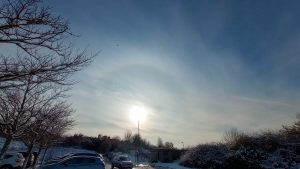
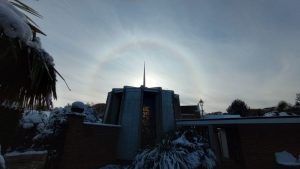
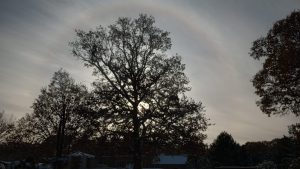
Nine CMHASD members attended the BAA Christmas meeting on the 10th December 2022, held at the Institute of Physics.
A recording of the meeting is available to watch here on the BAA YouTube channel.
Below are the times of the talks in the recording. Please be aware the sound is a little quiet at times so you will need to turn up the sound up. Talks particular of interest to our Society are in bold; as they have CMHASD member 'participation' :-)
Start – David Arditti, BAA President – Welcome, notices and awards - Here you will see CMHASD trustees Martin Crow and Simon Dawes collect their BAA Sir Patrick Moore award for their contributions to the ExoClock Project.
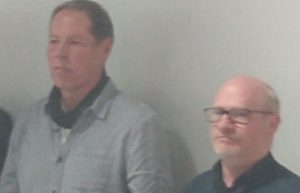
0h 27m – Tim Parsons – A Massive Star Menagerie: touring through the upper reaches of the H-R Diagram
1h 25m – Simon Kidd – Asteroid Occultations….an observer’s view
2h 8m – Nick James – Sky Notes - Here you will see CMHASD member Honor Wheeler's Moon image displayed during Nick's talk and a photo of a model of Jupiter that was used at the News Scientist Live exhibition 2022. CMHASD member Janice McClean, who is the BAA Events Manager and several other CMHASD members helped run the BAA stand at the exhibition over the 3 days.

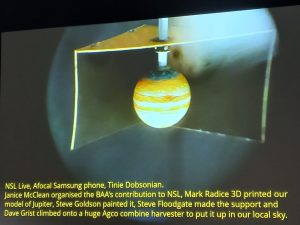
After the meeting for those who wished to partake - members were invited the BAA Christmas social, taking place in the Hubble Room at The Astronomer pub near Liverpool Street Station. Several CMHASD members took up the invite :-D I wonder who was one of the members?


Below are more photos of the day taken by CMHASD Chairperson John Archer & CMHASD Trustee John Howarth. Thank you for sharing your photos with us.
[ngg src="galleries" ids="70" display="basic_slideshow"]